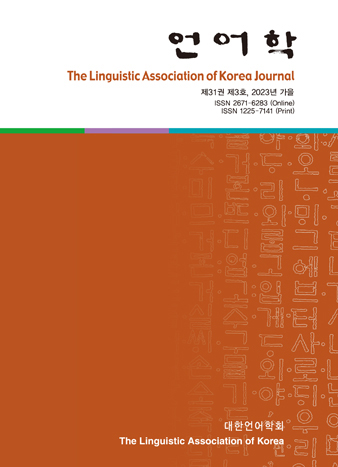대한언어학회 전자저널

-
온라인 수업에서 상호작용 교수설계가 학습몰입과 학습지속의향에 미치는 영향: N대학 교양영어 수업의 사례를 중심으로
-
The Internal Structure of Reflexives and a NP-internal Movement Analysis
-
Chinese Undergraduate Students’ Motivation to Learn L2 English and L3 Korean Simultaneously
-
What Restricts or Boosts the Use of Internally-Headed Relative Clauses in Korean?
-
English Wh-Question Formation by Korean Elementary and Middle School EFL Students
-
Korean ESL Learners’ Individual Differences in Intercultural Sensitivity and Language Development
31권 3호 (2023년 9월)
Abstract
Keywords
# corrective coordination # adversative coordination # -la # Korean
References
- Anscombre, J.-C., & Ducrot, O. (1977). Deux mais en français?. Lingua, 43(1), 23-40.
- Blakemore, D. (1989). Denial and contrast: A Relevance Theoretic analysis of but. Linguistics and Philosophy, 12(1), 15-37.
- Chierchia, G., & McConnell-Ginet, S. (2000). Meaning and grammar: An introduction to semantics. Cambridge, MA: MIT Press.
- Cho, D.-I. (1994). Functional Projections and Verb Movement. In Y.-K. Kim- Renaud (Eds.), Theoretical Issues in Korean Linguistics. Stanford: CSLI Publications.
- Chomsky, N. (1957). Syntactic Structures. The Hague: Mouton.
- Choi, S. (2020). Development of clause chaining in Korean. Frontiers in Psychology, 11, 256.
- Foolen, A. (1991). Polyfunctionality and the semantics of adversative conjunctions, Multilingua, 10, 79-92.
- Greenberg, Y. (2017). But, scalar implicatures and covert quotation operators. In proceedings of 21 st Amsterdam Colloquium. 275-284.
- Han, C.-H., Lidz, J., & Musolino, J. (2005). Verb-Raising and Grammar Competition i n Korean: Evidence from Negation and Quantifier Scope, Linguistic Inquiry, 38,1-47.
- Haspelmath, M. (2007). Coordination. In T. Shopen (Eds.), Language Typology and Syntactic Description Vol. 2: Complex Constructions. Cambridge University Press.
- Hudson, R. (1984). Word Grammar. Oxford: Basil Blackwell.
- Iatridou, S. (1990). About Agr(P). Linguistic Inquiry, 21, 551-577.
- Kang, Y.-S. (1986). Korean syntax and universal grammar. Doctoral dissertation, Harvard University.
- Kim, H. (1992). Clause Combining in Discourse and Grammar: An Analysis of Some Korean Clausal Connectives In Discourse. Ph.D. thesis, University of Hawai’i, Honolulu, HI.
- Kim, J-B., & I. A. Sag. (2002). Negation without head-movement. Natural Language and Linguistic Theory, 20, 339-412.
- Kim, Y.-J. (1990). The syntax and semantic of Korean Case: The interaction between lexical and syntactic levels of representation. Doctoral dissertation, Harvard University.
- Kim, Y.-J. (1991). Default nominative Case in Korean, Studies in Generative Grammar, 2, 113-148.
- Ko, H-J. (2009). Multiple Case Sharing and Syntactic Structure. Studies in Generative Grammar, 19(4), 423-451
- Kwon, I. (2017). Correction and compensation: The taysin construction in Korean. Lingua, 195, 92-109.
- Lang, E. (1984). The semantics of coordination. Amsterdam: John Benjamins.
- Langacker, R. (1969). On pronominalization and the chain of command. In Schane,S. & Reibel, D. (Eds.), Modern studies in English, 160–186. Englewood Cliffs: Prentice-Hall.
- Lee, E.-K. (1996). A Study on connective endings in Korean. Unpublished doctoral dissertation, Seoul National University.
- Lee, H. (2008). Criteria! Effects and Multiple Nominative Constructions. Studies in Generative Grammar, 18, 477-508.
- Lee, Y. (2017). The Two Meanings of taysin and Two Concepts of Contrast. Studies in Linguistics, 45, 157-176.
- Lim, D.-H. (2009). The Grammatical Status of Korean coordinating constructions, The Society of Korean Linguistics, 56, 87-130.
- Lyons, J. (1968). Introduction to Theoretical Linguistics. NY: Cambridge University Press.
- McCawley, J. D. (1991). Contrastive negation and metalinguistic negation. Chicago Linguistic Society (CLS), 2(2). 189-206.
- Merchant, J. (2001). The syntax of silence: sluicing, islands, and the theory of ellipsis. Oxford: Oxford University Press.
- Mittwoch, A. (1983). Backward anaphora and discourse structure. Journal of Pragmatics, 7(2), 129-139.
- Munn, A. (1987). Coordinate Structure and X-bar Theory. McGill Working Papers in Linguistics, 4.
- Park, K. (2016). A Comparative Study on the AND-constructions in English and Their Corresponding ‘-ko/-wa’ Constructions in Korean. The Linguistic Association of Korea Journal, 24(2), 183-196.
- Partee, B., & Rooth, M. (1983). Generalized conjunction and type ambiguity. In Bäuerle, R., Schwarze, C. & von Stechow, A. (Eds.), Meaning, use, and interpretation of language, 361–383. Berlin: Walter de Gruyter.
- Pesetsky D., & Torrego E. (2004). Tense, case, and the nature of syntactic categories. In The Syntax of Time, Jacqueline Gueron, Jacqueline Lecarme (eds.), 495-538. Cambridge, MA: Massachusetts Institute of Technology Press.
- Pesetsky, D., & Torrego, E. (2007). The syntax of valuation and the interpretability of features. Phrasal and Clausal Architecture, 262-294.
- Reinhart, T. (1986). Center and Periphery in the Grammar of Anaphora, In B. Lust (Eds.) Studies in the Acquisition of Anaphora, 123-150, Dordrecht: D. Reidel.
- Ross, J. (1967). Constraints on variables in syntax. Doctoral dissertation, MIT.
- Schütze, C. T. R. (2001). On the nature of default Case. Syntax, 4(3), 205-238
- Shitrit, R. (2015). x aval X: A semantic-pragmatic analysis. Master’s thesis, Bar-Ilan University.
- Song, S.-C. (1988). Explorations in Korean Syntax and Semantics. Berkeley, CA: UC-Berkeley Institute of East Asian Studies.
- Toosarvandani, M. (2010). Association with foci. Unpublished doctoral dissertation, University of California, Berkeley.
- Toosarvandani, M. (2013). Corrective but coordinates clauses not always but sometimes. Natural Language and Linguistic Theory, 31(3). 827–863.
- Vela-Plo, L. (2018). Smaller than small comparatives: The case of Basque. Borealis– An International. Journal of Hispanic Linguistics, 7(1), 45–69.
- Vela-Plo, L. (2023). Phrasal subcomparatives: a comparative coordination analysis based on evidence from Basque, Spanish, and English. Linguistics, 61(1), 107-157.
- Vicente, L. (2010). On the syntax of adversative coordination. Natural Language and Linguistic Theory, 28(2), 381–415.
- Williams, E. (1977). Discourse and logical form, Linguistic Inquiry, 8(1), 101-139.
- Winter, Y., & Rimon, M. (1994). Contrast and implication in natural language. Journal of Semantics, 11(4), 365-406.
- Yoon, J. M. (1990). Verb Movement and the Structure of IP in Korean. Language Research, 26(2), 343-371.